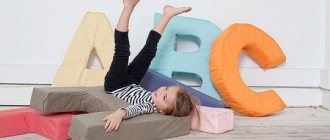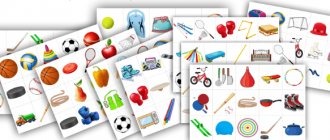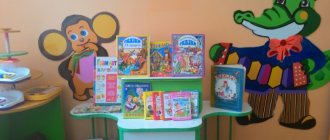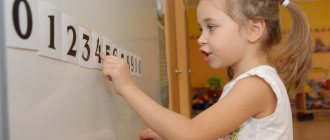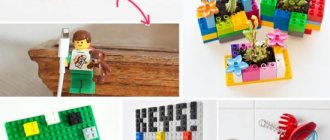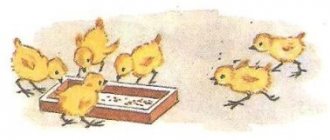Mathematics is the oldest and greatest science about order, relationships, and numbers. The basis of which are counting operations: addition, subtraction, multiplication, division.
Sign up for the course “Speed up mental arithmetic, NOT mental arithmetic” to learn how to quickly and correctly add, subtract, multiply, divide, square numbers and even extract roots. In 30 days, you'll learn how to use easy tricks to simplify arithmetic operations. Each lesson contains new techniques, clear examples and useful tasks.
Sign up for a courseRead more
- Mathematics classes (ranks and classes)
- Mathematics 1st grade
- Mathematics 2nd grade
- Mathematics 3rd grade
- Mathematics 4th grade
- Mathematics 5th grade
- Mathematics 6th grade
- Score development games
- Development of phenomenal mental arithmetic
Also, each person had his own plot of land. There was a need to measure your plot of land.
A person had a need to calculate, to measure everything around him (stocks, livestock, food, land, building a house, and so on.)
In addition to the above, a person learned to determine the shapes and sizes of surrounding objects, that is. it is round or square or oval... This means showing interest in the spatial forms of the real world.
Mathematics is so important in our world that there is not a single profession that does not require mathematics.
Carl Friedrich Gauss once said: “Mathematics is the queen of sciences, arithmetic is the queen of mathematics.”
But it is so. Arithmetic is a branch of mathematics that works with numbers and calculations (operations with numbers).
Arithmetic begins to be studied in elementary school, because it is the basis of mathematics; basic operations with numbers are studied there: addition, subtraction, multiplication, division.
Sign up for the course “Speed up mental arithmetic, NOT mental arithmetic” to learn how to quickly and correctly add, subtract, multiply, divide, square numbers and even extract roots. In 30 days, you'll learn how to use easy tricks to simplify arithmetic operations. Each lesson contains new techniques, clear examples and useful tasks.
Sign up for a courseRead more
Mathematics classes (ranks and classes)
To make it easier for children, and not only children, to navigate numbers, a division of numbers into classes and ranks was invented.
Let's imagine the number 148951784296, and divide it by three digits: 148,951,784,296. So, from right to left: 296 is the class of units, 784 is the class of thousands, 951 is the class of millions, 148 is the class of billions. In turn, in each class 3 digits have their own digit. From right to left: the first digit is units, the second digit is tens, the third is hundreds. For example, the class of units is 296, 6 is ones, 9 is tens, 2 is hundreds.
This division is really very convenient and easy to remember. It is much easier when teaching children mathematics, when talking about some operation, to talk about how to fold in a column, for example. Because during the story you can name numbers by rank and class, and this will be much clearer to the student than simply calling them numbers.
Mathematics 1st grade
In the first grade they take a section of mathematics - arithmetic. Arithmetic is a branch of mathematics that works with numbers and calculations (operations with numbers).
In the first grade, as a rule, they go through the first two simplest operations with numbers: addition, subtraction.
Addition is an arithmetic operation in which two numbers are added, and their result is a new third.
The addition formula is expressed as follows: a + b = c .
Subtraction is an arithmetic operation in which the second number is subtracted from the first number, and the result is the third.
The addition formula is expressed as follows: a - b = c .
Transactions are carried out in single digits. Double digits are rare. Because it is necessary for children to get used to it and understand the technique.
Examples for training:
Task No. 1:
Task No. 2:
General training rules
At the first stage, kids become familiar with numbers and the diversity of the world around them. And only then do parents and their children begin to count how many steps there are on the stairs, cars in the parking lot, pots in the cupboard, and so on. This uses your fingers. Small children cannot perform arithmetic operations without the help of objects.
You cannot criticize for any failures! The mother should be patient and choose a simpler example if the one already given to the baby is not clear. He must clearly understand that the action expressed by the words “plus one” is an addition. And to complete it, you need to name the next serial digit.
Along the way, children become familiar with the concepts of “equal,” “more,” and “less.” They also decompose numbers from 2 to 10. For example, 6 is 2+4, 3+3, 4+2 and 5+1. The young mathematician must remember all the variants of decomposition of numbers up to 10!
Only after mastering all of the listed skills can you begin to calculate with the transition through ten. It is recommended to start the first lessons at the age of three. And the complication begins at 4-5 years.
Mathematics 2nd grade
The second class is more serious than the first. Operations are performed with two-digit numbers. In addition to addition and subtraction, there is the operation “more than, less than or equal to .
The essence of the operation “greater than, less than or equal to” is to compare two numbers.
The < sign means “less than”, the > sign means “greater than” and, accordingly, = equals.
For example, you need to compare two numbers 25 and 40
25 < 40, 25 less than 40.
49 and 14. 49>14, 49 is more than fourteen.
It is set equal if the number on the left and right is the same, or the expression is equivalent.
Examples for training:
Task No. 1:
Task No. 2:
Mathematics 4th grade
In the fourth grade, there is active work with units of measurement: length (cm, dts, m, km), mass (g, kg), time (s, h), speed (m/s, km/h). And also work with previous operations accordingly.
We are studying mathematical equations with one unknown.
Examples for training:
Task No. 1:
Task No. 2:
- A man on a bicycle covered the distance from the city to the village, equal to 60 km, in 4 hours. On the way back he slowed down by 3 km/h. How long did the cyclist spend on the train?
- The plane's 16-hour journey is 4,150 km long. The plane flew for 3 hours at a speed of 660 km/h and another 2 hours at a speed of 730 km/h. How far does the plane have to travel in the last hour?
- In 5 hours, the corn farmer flew 220 km. What distance will the corn truck cover if the speed is increased by 7 km/h?
Counting in your head
The requirements for modern children are very high - preschoolers must have all the basic knowledge.
It is normal for children aged 3-4 years to count objects by bending their fingers. For example, they enjoy finding out how many spoons, plates or cups are on the dining table. But from about 5 years old, the skill of mental calculations should be developed, without the use of improvised means.
Mathematics 5th grade
In the fifth grade, students begin to study topics such as fractions and mixed numbers. You can find information about operations with these numbers in our articles on the relevant operations.
A fraction is the ratio of two numbers to each other or the numerator to the denominator. A fractional number can be replaced by division. For example, ¼ = 1:4.
A mixed number is a fractional number with only the integer part highlighted. The integer part is allocated provided that the numerator is greater than the denominator. For example, there was a fraction: 5/4, it can be transformed by highlighting the whole part: one whole and ¼.
Examples for training:
Task No. 1:
Task No. 2:
Mathematics 6th grade
In 6th grade, the topic of converting fractions to lowercase notation appears. What does it mean? For example, given the fraction ½, it will be equal to 0.5. ¼ = 0.25.
Examples can be compiled in the following style: 0.25+0.73+12/31.
Examples for training:
Task No. 1:
Task No. 2:
Task No. 3:
- There were a total of 92 chairs in the two classrooms. 16 chairs were moved from the first class to the second class and then their number was equalized. How many chairs were there in first and second class initially?
- There were 240 kg of apples in two boxes. 18 kg of apples were transferred from the second box to the first. Afterwards, the number of apples in the first and second boxes was equal. How many kilograms of apples were initially in the first and second box?
- The motorist left the city for the village at a speed of 11.5 km/h. After 2.4 hours, a bus left from the same place and in the same direction at a speed of 46 km/h. How long will it take for the bus to catch up with the car?
Games for developing mental arithmetic
Special educational games developed with the participation of Russian scientists from Skolkovo will help improve mental arithmetic skills in an interesting game form.
Game "Quick Count"
The game "quick count" will help you improve your thinking . The essence of the game is that in the picture presented to you, you will need to choose the answer “yes” or “no” to the question “are there 5 identical fruits?” Follow your goal, and this game will help you with this.
Play now
Game "Quick addition"
The game "Quick Addition" develops thinking and memory. The main essence of the game is to choose numbers whose sum is equal to a given number. In this game, a matrix from one to sixteen is given. A given number is written above the matrix; you need to select the numbers in the matrix so that the sum of these digits is equal to the given number. If you answered correctly, you score points and continue playing.
Play now
Game "Guess the operation"
The game “Guess the Operation” develops thinking and memory. The main point of the game is to choose a mathematical sign for the equality to be true. Examples are given on the screen, look carefully and put the required “+” or “-” sign so that the equality is true. The “+” and “-” signs are located at the bottom of the picture, select the desired sign and click on the desired button. If you answered correctly, you score points and continue playing.
Play now
Game "Mathematical matrices"
“Mathematical matrices” is an excellent exercise for the children’s brain , which will help you develop their mental work, mental calculation, quick search for the necessary components, and attentiveness. The essence of the game is that the player has to find a pair from the proposed 16 numbers that will add up to a given number, for example in the picture below the given number is “29”, and the desired pair is “5” and “24”.
Play now
Game "Visual Geometry"
The game "Visual Geometry" develops thinking and memory. The main essence of the game is to quickly count the number of shaded objects and select it from the list of answers. In this game, blue squares are shown on the screen for a few seconds, you need to quickly count them, then they close. Below the table there are four numbers written, you need to select one correct number and click on it with the mouse. If you answered correctly, you score points and continue playing.
Play now
Game "Simplification"
The game “Simplification” develops thinking and memory. The main essence of the game is to quickly perform a mathematical operation. A student is drawn on the screen at the blackboard, and a mathematical operation is given; the student needs to calculate this example and write the answer. Below are three answers, count and click the number you need using the mouse. If you answered correctly, you score points and continue playing.
Play now
From 1 to 20
The next stage will be more difficult. You can't do without improvised means here. For example, on the way to kindergarten you may find out that there are more than ten cars in the parking lot. The child will quickly cope with a simple listing in order. It is enough to explain to him that the ending “-twenty” should be added to the usual numbers after 10: one is eleven, two is twelve, and so on.
Example explanation:
- You need to take ten colorful cubes and place them in a row. Along the way, it is worth explaining that this row means ten or one “twenty”.
- Then, in front of the little mathematician's eyes, the next row should be placed on each of the cubes. And say that this is the second ten. The first cube of the second row is a one placed on ten or “twenty” (one-by-twenty). We get eleven. The second die is a two placed on “twenty” (two-by-twenty) or twelve. With this simple method, children quickly understand the structure of numbers up to 19.
- The number 20 is 2 plus “twenty” (two rows of 10 cubes), that is, twenty. Similarly, we can explain all the names of tens up to 100.
Development of phenomenal mental arithmetic
We have looked at only the tip of the iceberg, to understand mathematics better - sign up for our course: Accelerating mental arithmetic - NOT mental arithmetic.
From the course you will not only learn dozens of techniques for simplified and quick multiplication, addition, multiplication, division, and calculating percentages, but you will also practice them in special tasks and educational games! Mental arithmetic also requires a lot of attention and concentration, which are actively trained when solving interesting problems.
Sign up for a courseRead more
Speed reading in 30 days
Increase your reading speed by 2-3 times in 30 days. From 150-200 to 300-600 words per minute or from 400 to 800-1200 words per minute. The course uses traditional exercises for the development of speed reading, techniques that speed up brain function, methods for progressively increasing reading speed, the psychology of speed reading and questions from course participants. Suitable for children and adults reading up to 5000 words per minute.
Sign up for a courseFree lesson
Development of memory and attention in a child 5-10 years old
The purpose of the course: to develop the child’s memory and attention so that it is easier for him to study at school, so that he can remember better.
After completing the course, the child will be able to:
- 2-5 times better to remember texts, faces, numbers, words
- Learn to remember for a longer period of time
- The speed of recalling the necessary information will increase
Sign up for a courseRead more
Super memory in 30 days
Remember the necessary information quickly and for a long time. Wondering how to open a door or wash your hair? I’m sure not, because this is part of our life. Easy and simple exercises for memory training can be made part of your life and done a little during the day. If you eat the daily amount of food at once, or you can eat in portions throughout the day.
Sign up for a courseRead more
How to improve memory and develop attention
Free practical lesson from advance.
Sign up for freeRead more
Secrets of brain fitness, training memory, attention, thinking, counting
The brain, like the body, needs fitness. Physical exercise strengthens the body, mental exercise develops the brain. 30 days of useful exercises and educational games to develop memory, concentration, intelligence and speed reading will strengthen the brain, turning it into a tough nut to crack.
Sign up for a courseRead more
Money and the Millionaire Mindset
Why are there problems with money? In this course we will answer this question in detail, look deep into the problem, and consider our relationship with money from psychological, economic and emotional points of view. From the course you will learn what you need to do to solve all your financial problems, start saving money and invest it in the future.
Knowledge of the psychology of money and how to work with it makes a person a millionaire. 80% of people take out more loans as their income increases, becoming even poorer. On the other hand, self-made millionaires will earn millions again in 3-5 years if they start from scratch. This course teaches you how to properly distribute income and reduce expenses, motivates you to study and achieve goals, teaches you how to invest money and recognize a scam.
Sign up for a courseRead more
Mathematics ability
Before starting training, parents must realize that all children are different! You can’t demand from your kindergartener what your neighbor’s girl or your best friend’s son can already do. Teachers note that not all young mathematicians have the same abilities. Conventionally, they distinguish the following groups:
- very capable children who grasp mathematics literally on the fly;
- kids with average abilities (probably future good students), who are given new skills through regular classes;
- and absolutely incapable of arithmetic - such children sometimes fail to count correctly even in a column, and this problem in some cases is lifelong (such an adult happily uses a calculator).
The ability to count quickly largely depends on the ability to instantly concentrate and natural abilities. You can improve your skills using special algorithms, and regular training (experience) will also come in handy.
Don’t despair if everything (in mom’s opinion) is very bad. The sooner your child becomes familiar with the principles of counting and numbers, the easier it will be for him at school. He may not become a child prodigy, but he is guaranteed to have fewer problems with arithmetic.
The main thing for parents is not to despair in case of the first failures and to treat such home education as a regular system for the development of their own child.
![Summary of a lesson on speech development for children 4–5 years old “Sound culture of speech: letter [p]”](https://mybabby.ru/wp-content/uploads/konspekt-zanyatiya-po-razvitiyu-rechi-dlya-detej-4-5-let-330x140.jpg)
